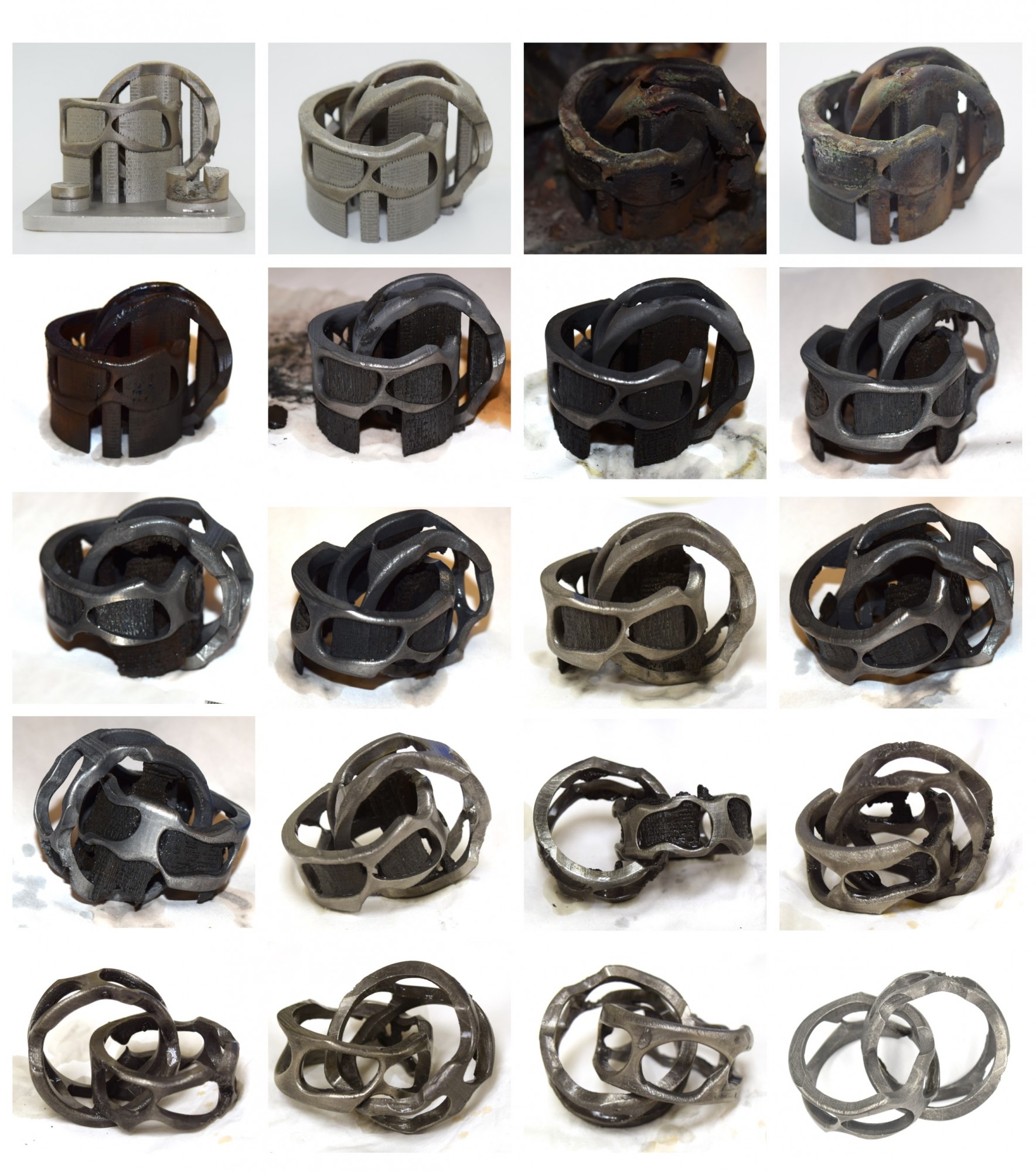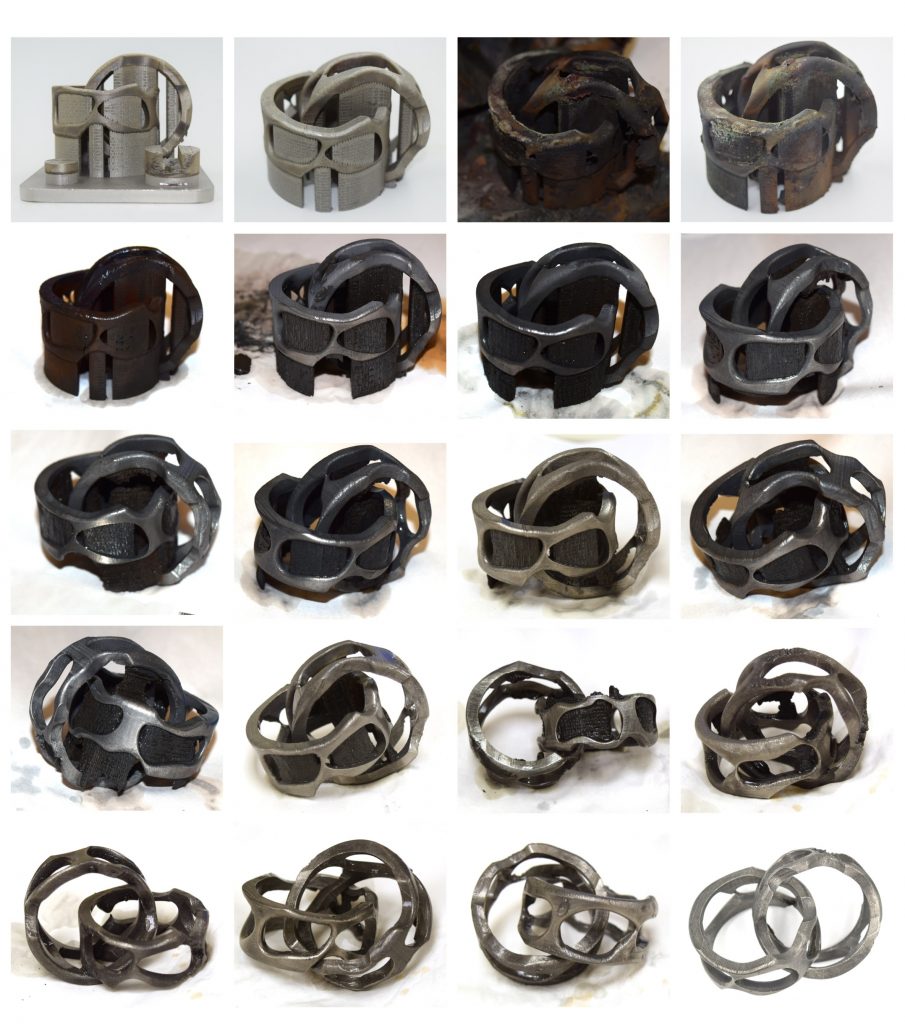Dissolvable Metal Supports for 3D Printing - for Real!

3D-printed interlocking stainless steel rings, showing progression of selectively dissolving the support structure. (Image courtesy ASU)
April 19, 2017
Support for a visiting professor plus an off-the-cuff remark have led an Arizona State University (ASU) researcher to develop what could be the Holy Grail solution to speeding up the end-to-end process of metal 3D printing.
Owen Hildreth, ASU assistant professor of 3D Nanofabrication, was developing new approaches to reactive silver ink production when he thought he’d sit in on talks regarding the soon-to-be-opened ASU Polytechnic Manufacturing Research and Innovation Hub. One of the speakers, Timothy Simpson, was describing the practical challenges of setting up an additive manufacturing (AM) lab.
Inspiration Meets Timing
As a research professor at Pennsylvania State University’s Center for Innovative Materials Processing through Direct Digital Deposition, Simpson had a particular interest in working with metals. And, as anyone who works with metal AM knows, support structures (especially necessary for heat-conduction and anchoring in powder-bed systems), require time-consuming hand-work to cut and smooth off. During his talk, Simpson casually mentioned, “If anyone knows of a water-soluble metal we could use for metal AM support structures, talk to me afterwards.”For reference, Stratasys, one of the power-house 3D printing companies for thermoplastic applications, developed a dissolvable support methodology some years ago. With the company’s Fused Deposition Modeling (FDM) filament systems, the equipment deposits ABS material for the part itself and dissolvable PLA for the supports. An analogous approach has yet to be discovered for metals, despite almost 30 years of work in the area.
Hildreth says his immediate response was, “Well, any metal could be dissolved if you control the local chemical environment — it’s just the oxide surface layer (produced regardless of the specific AM metal technology) that gets in the way.” And he thought he could get around the oxide problem using principles of sacrificial anodes such as those used to protect stainless steel ships’ hulls from corrosion — let something else take the brunt of the effect.
Taking an Electrochemical, Not Mechanical, Approach
Combining a mechanical engineering degree (applied to five years’ work in the 2D printing industry) with a Ph.D. in nanofabrication materials engineering, Hildreth just may have been in the perfect position to bring a fresh perspective to the metal support problem. In contrast to the use of mechanical tools such as wire-EDM equipment, his concept would cause certain areas of a metal AM part to react chemically when immersed in a corrosive solution. The goal was to produce controlled degradation that would literally eat away the supports but leave the actual part virtually intact.Hildreth worked with several test scenarios. He first asked Simpson to produce a 1-in. stainless steel arch with carbon steel supports in the opening, built on the Pennsylvania State University’s Optomec Direct Metal Deposition system. (That system can create parts using more than one material.) A nitric acid solution used with bubbling O2 to encourage oxidation, controlled by a saturated hydrogen electrode, successfully etched away just the carbon steel.
However, because multi-material 3D printing systems are not yet widely available, Hildreth also investigated ways to selectively remove the supports of powder-bed-type metal AM parts. Starting with a simple design for demonstration — a small 17-4 stainless steel cylinder 3D-printed with a single row of 100-micron-diameter needle-like supports — he tested two possible approaches.
In the first one, termed direct dissolution, the part was heat-treated (annealed) while packed with sodium ferrocyanide; this step precipitated out much of the protective chromium carbide, rendering the no-longer-stainless steel susceptible to chemical etching. The latter process was successful, but the part itself experienced significant etching, which continued the longer the part was allowed to sit in the solution.
Drastically Reducing Post-Processing Time
 3D-printed interlocking stainless steel rings, showing progression of selectively dissolving the support structure. (Image courtesy ASU)
3D-printed interlocking stainless steel rings, showing progression of selectively dissolving the support structure. (Image courtesy ASU)To make the process less time-sensitive (self-terminating), Hildreth introduced a sensitizing agent, sodium hexacyanoferrate, during the post-print annealing step. At high temperatures, this chemical decomposes to give off carbon and nitrogen that diffuses into the stainless steel part to effectively turn the top 100 to 200 microns into carbon steel instead of stainless steel. Since the supports are only around 125 microns thick, they are completely “sensitized” while only a thin shell of the actual component is transformed. By applying the right bias voltage and chemistry, the supports become subject to anodic corrosion while the part itself takes on the role of a cathode and remains protected.
A more intricate design of interlocking stainless steel rings, fabricated on an EOS laser-sintered powder-bed system presented a good test, with its nest of densely packed vertical supports. After seven hours of etching the parts, the components broke free from their supports; this may seem like a long time, but traditional machining would have taken 32 to 40 hours to do the same.
With machine shop rates typically running $30 to $100/hour, this mostly unattended, self-terminating process represents a significant savings in terms of cost, time and complexity.
Hildreth’s work was recently featured in 3D Printing and Additive Manufacturing (see “Dissolvable Supports in Powder Bed Fusion-Printed Stainless Steel,” Vol. 4, No. 1 2017 for more details). He is currently seeking funding to refine the process and extend it to other metals using different sensitizing solutions and process parameters.
Subscribe to our FREE magazine, FREE email newsletters or both!
About the Author
Pamela Waterman worked as Digital Engineering’s contributing editor for two decades. Contact her via .(JavaScript must be enabled to view this email address).
Follow DE





